Management Accounting: Principles and Techniques for Sustainable Success
VerifiedAdded on 2024/06/07
|21
|4415
|400
AI Summary
This report delves into the fundamental principles and techniques of management accounting, exploring its role in organizational planning and strategic decision-making. It examines different types of accounting systems, including cost accounting, inventory management, and job costing, and analyzes their application in a medium-sized manufacturing organization. The report further investigates the significance of management accounting information in an understandable manner, highlighting its importance for cost control, performance evaluation, and resource allocation. It also explores the merits and demerits of various planning tools, such as standard costing, responsibility budgeting, and flexible budgeting, and their application in budget preparation. The report concludes by examining how management accounting techniques can be used to overcome financial problems and achieve sustainable success.
Contribute Materials
Your contribution can guide someone’s learning journey. Share your
documents today.
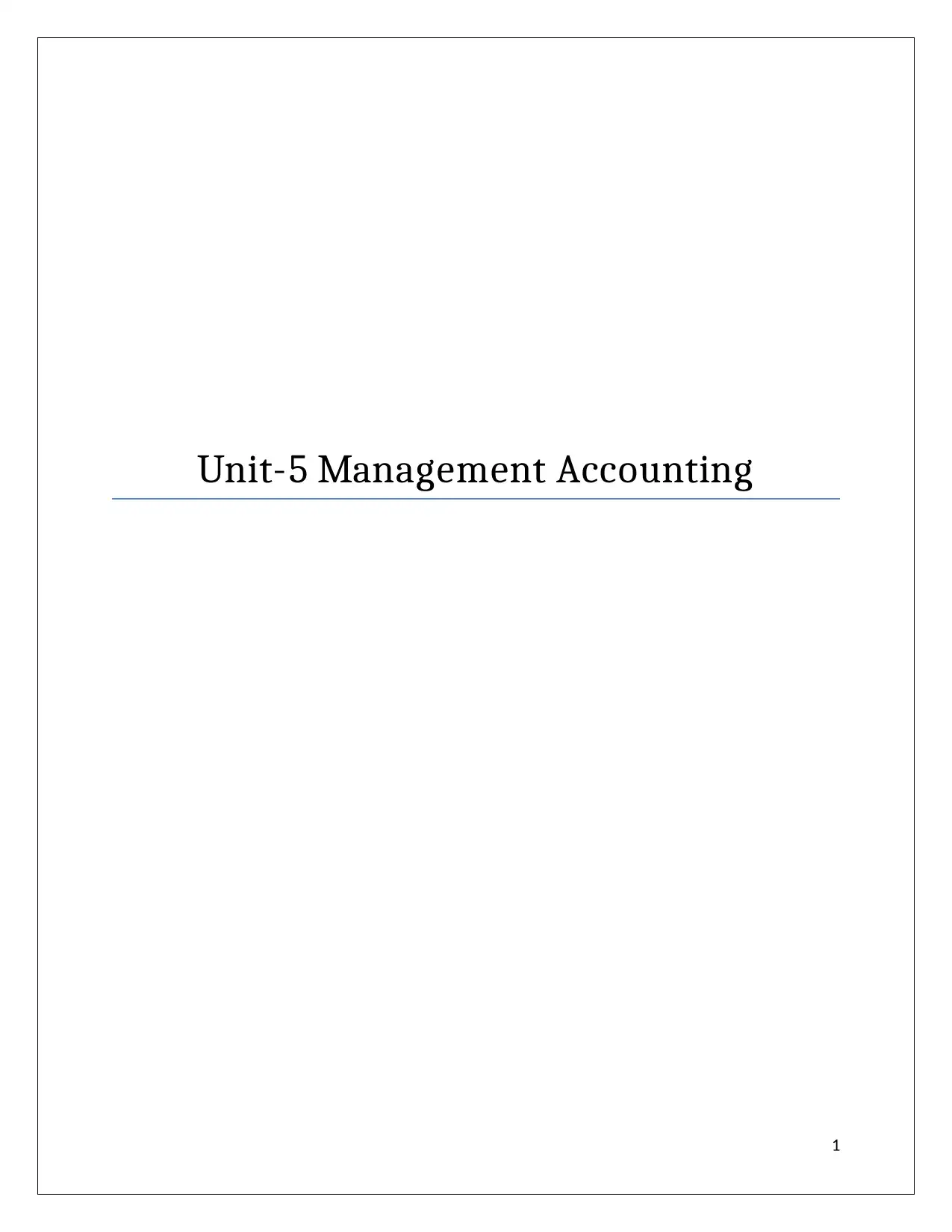
Unit-5 Management Accounting
1
1
Secure Best Marks with AI Grader
Need help grading? Try our AI Grader for instant feedback on your assignments.
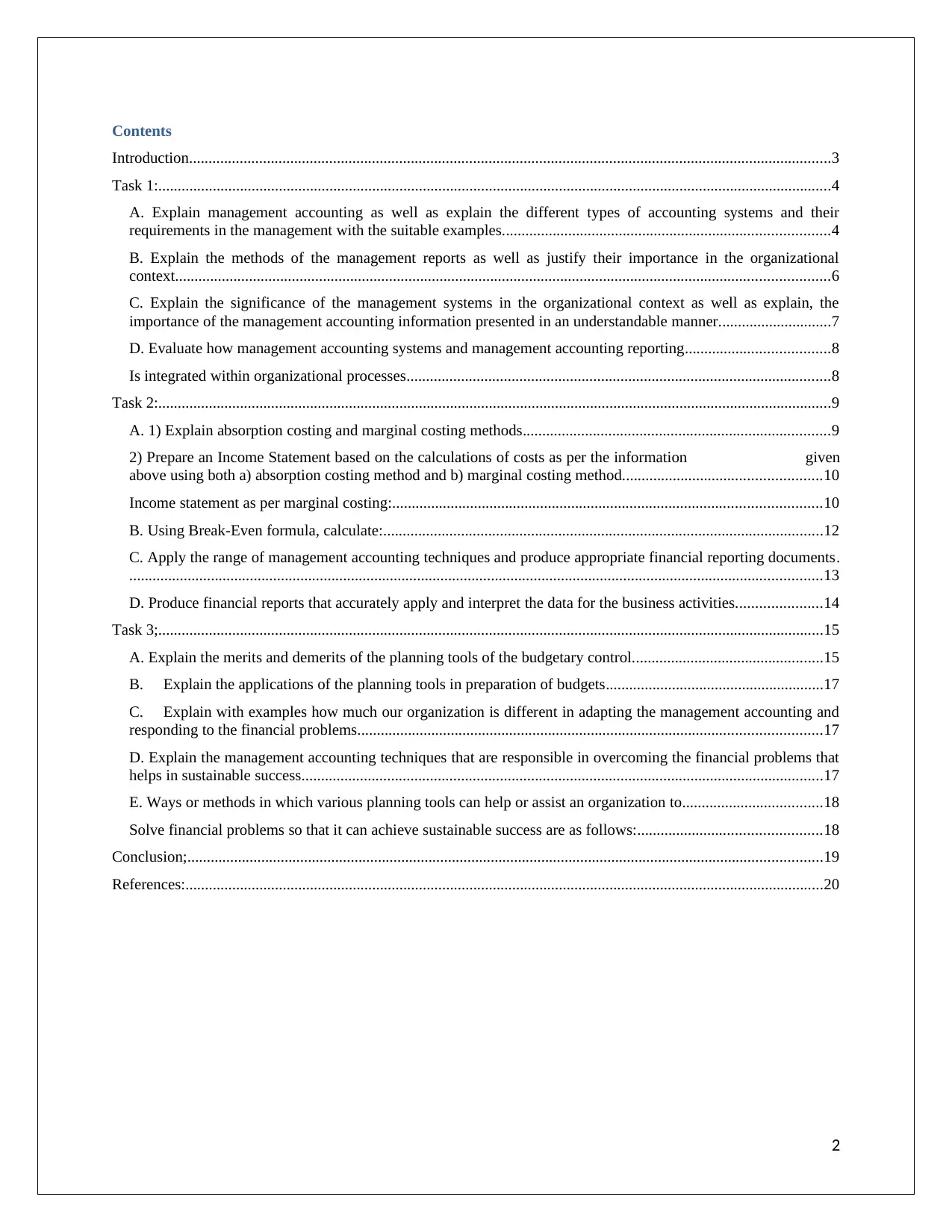
Contents
Introduction.....................................................................................................................................................................3
Task 1:.............................................................................................................................................................................4
A. Explain management accounting as well as explain the different types of accounting systems and their
requirements in the management with the suitable examples....................................................................................4
B. Explain the methods of the management reports as well as justify their importance in the organizational
context........................................................................................................................................................................6
C. Explain the significance of the management systems in the organizational context as well as explain, the
importance of the management accounting information presented in an understandable manner.............................7
D. Evaluate how management accounting systems and management accounting reporting.....................................8
Is integrated within organizational processes.............................................................................................................8
Task 2:.............................................................................................................................................................................9
A. 1) Explain absorption costing and marginal costing methods...............................................................................9
2) Prepare an Income Statement based on the calculations of costs as per the information given
above using both a) absorption costing method and b) marginal costing method...................................................10
Income statement as per marginal costing:..............................................................................................................10
B. Using Break-Even formula, calculate:.................................................................................................................12
C. Apply the range of management accounting techniques and produce appropriate financial reporting documents.
..................................................................................................................................................................................13
D. Produce financial reports that accurately apply and interpret the data for the business activities......................14
Task 3;...........................................................................................................................................................................15
A. Explain the merits and demerits of the planning tools of the budgetary control.................................................15
B. Explain the applications of the planning tools in preparation of budgets........................................................17
C. Explain with examples how much our organization is different in adapting the management accounting and
responding to the financial problems.......................................................................................................................17
D. Explain the management accounting techniques that are responsible in overcoming the financial problems that
helps in sustainable success......................................................................................................................................17
E. Ways or methods in which various planning tools can help or assist an organization to....................................18
Solve financial problems so that it can achieve sustainable success are as follows:...............................................18
Conclusion;...................................................................................................................................................................19
References:....................................................................................................................................................................20
2
Introduction.....................................................................................................................................................................3
Task 1:.............................................................................................................................................................................4
A. Explain management accounting as well as explain the different types of accounting systems and their
requirements in the management with the suitable examples....................................................................................4
B. Explain the methods of the management reports as well as justify their importance in the organizational
context........................................................................................................................................................................6
C. Explain the significance of the management systems in the organizational context as well as explain, the
importance of the management accounting information presented in an understandable manner.............................7
D. Evaluate how management accounting systems and management accounting reporting.....................................8
Is integrated within organizational processes.............................................................................................................8
Task 2:.............................................................................................................................................................................9
A. 1) Explain absorption costing and marginal costing methods...............................................................................9
2) Prepare an Income Statement based on the calculations of costs as per the information given
above using both a) absorption costing method and b) marginal costing method...................................................10
Income statement as per marginal costing:..............................................................................................................10
B. Using Break-Even formula, calculate:.................................................................................................................12
C. Apply the range of management accounting techniques and produce appropriate financial reporting documents.
..................................................................................................................................................................................13
D. Produce financial reports that accurately apply and interpret the data for the business activities......................14
Task 3;...........................................................................................................................................................................15
A. Explain the merits and demerits of the planning tools of the budgetary control.................................................15
B. Explain the applications of the planning tools in preparation of budgets........................................................17
C. Explain with examples how much our organization is different in adapting the management accounting and
responding to the financial problems.......................................................................................................................17
D. Explain the management accounting techniques that are responsible in overcoming the financial problems that
helps in sustainable success......................................................................................................................................17
E. Ways or methods in which various planning tools can help or assist an organization to....................................18
Solve financial problems so that it can achieve sustainable success are as follows:...............................................18
Conclusion;...................................................................................................................................................................19
References:....................................................................................................................................................................20
2

Introduction
The preparation of following report is concerned with obtaining a detailed knowledge about the
management accounting principles and techniques that can be used in an organisation for
planning and strategically purposes. The use of management accounting traditionally was limited
for the purpose of presenting information to the management but in modern business
environment they same has been used for producing value added reports for business managers
and assisting them in taking critical business decisions. The report will involve an explanation
regarding the management accounting systems and their application in an organizational context.
The organisation selected here will be a medium sized organisation which is operating in
manufacturing industry. The report will include the detailed explanation regarding the two
techniques of costing covering absorption costing and marginal costing. The income statements
will be produced based on these techniques. Further the report will also include a detailed
knowledge about the various planning tools and techniques that can be used in an enterprise for
making plans and solving the financial problems.
3
The preparation of following report is concerned with obtaining a detailed knowledge about the
management accounting principles and techniques that can be used in an organisation for
planning and strategically purposes. The use of management accounting traditionally was limited
for the purpose of presenting information to the management but in modern business
environment they same has been used for producing value added reports for business managers
and assisting them in taking critical business decisions. The report will involve an explanation
regarding the management accounting systems and their application in an organizational context.
The organisation selected here will be a medium sized organisation which is operating in
manufacturing industry. The report will include the detailed explanation regarding the two
techniques of costing covering absorption costing and marginal costing. The income statements
will be produced based on these techniques. Further the report will also include a detailed
knowledge about the various planning tools and techniques that can be used in an enterprise for
making plans and solving the financial problems.
3

Task 1:
A. Explain management accounting as well as explain the different types of accounting
systems and their requirements in the management with the suitable examples.
The term management accounting refers to the set of accounting conducted in an enterprise for
producing appropriate reports that can be used by management in decision making purposes. The
process of management accounting involves identifying the critical sources of information and
recording and presenting the data in a report format in order to provide accurate and timely
information to the management. The information will thus be utilized for the purpose of making
economic decision in the company. The system of management accounting will be used in a
manufacturing organisation in order to keep record of manufacturing operations of the company
and analysing the efficiency and effectiveness with which they are conducted (Charles, et. al.,
2017).
Difference between management accounting and financial accounting:
Objective – The objective of management accounting is to assist business managers in taking
significant decision regarding the company. The reports will be utilized for evaluating and
analysing the performance of company and the decision will be taken accordingly. However
financial accounting is the form of accounting in which financial reports are presented to the
investors and other outsiders in order to assist them in taking their investment decisions.
Users – The users which are concerned with management accounting reports are associated with
internal people of the organisation consisting of employees, managers etc. whereas the financial
accounting reports are used by external people of organisation consisting of investors, creditors
etc.
Frequency of reporting – The management accounting reports can be prepared at the will of the
management and there is no boundation for preparing the same at a regular interval if time.
However the financial reports are subjected to regulations in which the periodical reports must be
prepared by the management in order to present the same before users (Carley and Christie,
2017).
4
A. Explain management accounting as well as explain the different types of accounting
systems and their requirements in the management with the suitable examples.
The term management accounting refers to the set of accounting conducted in an enterprise for
producing appropriate reports that can be used by management in decision making purposes. The
process of management accounting involves identifying the critical sources of information and
recording and presenting the data in a report format in order to provide accurate and timely
information to the management. The information will thus be utilized for the purpose of making
economic decision in the company. The system of management accounting will be used in a
manufacturing organisation in order to keep record of manufacturing operations of the company
and analysing the efficiency and effectiveness with which they are conducted (Charles, et. al.,
2017).
Difference between management accounting and financial accounting:
Objective – The objective of management accounting is to assist business managers in taking
significant decision regarding the company. The reports will be utilized for evaluating and
analysing the performance of company and the decision will be taken accordingly. However
financial accounting is the form of accounting in which financial reports are presented to the
investors and other outsiders in order to assist them in taking their investment decisions.
Users – The users which are concerned with management accounting reports are associated with
internal people of the organisation consisting of employees, managers etc. whereas the financial
accounting reports are used by external people of organisation consisting of investors, creditors
etc.
Frequency of reporting – The management accounting reports can be prepared at the will of the
management and there is no boundation for preparing the same at a regular interval if time.
However the financial reports are subjected to regulations in which the periodical reports must be
prepared by the management in order to present the same before users (Carley and Christie,
2017).
4
Secure Best Marks with AI Grader
Need help grading? Try our AI Grader for instant feedback on your assignments.
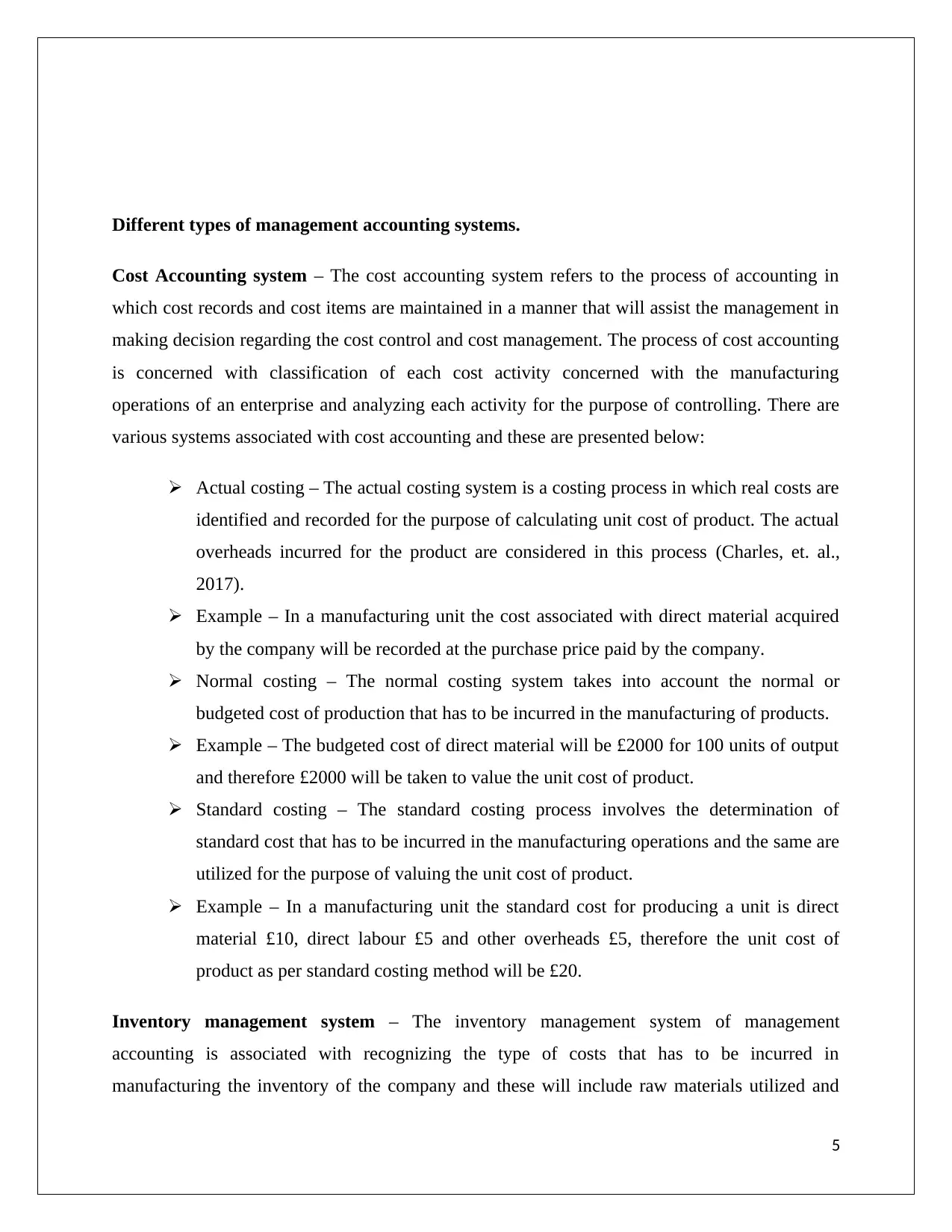
Different types of management accounting systems.
Cost Accounting system – The cost accounting system refers to the process of accounting in
which cost records and cost items are maintained in a manner that will assist the management in
making decision regarding the cost control and cost management. The process of cost accounting
is concerned with classification of each cost activity concerned with the manufacturing
operations of an enterprise and analyzing each activity for the purpose of controlling. There are
various systems associated with cost accounting and these are presented below:
Actual costing – The actual costing system is a costing process in which real costs are
identified and recorded for the purpose of calculating unit cost of product. The actual
overheads incurred for the product are considered in this process (Charles, et. al.,
2017).
Example – In a manufacturing unit the cost associated with direct material acquired
by the company will be recorded at the purchase price paid by the company.
Normal costing – The normal costing system takes into account the normal or
budgeted cost of production that has to be incurred in the manufacturing of products.
Example – The budgeted cost of direct material will be £2000 for 100 units of output
and therefore £2000 will be taken to value the unit cost of product.
Standard costing – The standard costing process involves the determination of
standard cost that has to be incurred in the manufacturing operations and the same are
utilized for the purpose of valuing the unit cost of product.
Example – In a manufacturing unit the standard cost for producing a unit is direct
material £10, direct labour £5 and other overheads £5, therefore the unit cost of
product as per standard costing method will be £20.
Inventory management system – The inventory management system of management
accounting is associated with recognizing the type of costs that has to be incurred in
manufacturing the inventory of the company and these will include raw materials utilized and
5
Cost Accounting system – The cost accounting system refers to the process of accounting in
which cost records and cost items are maintained in a manner that will assist the management in
making decision regarding the cost control and cost management. The process of cost accounting
is concerned with classification of each cost activity concerned with the manufacturing
operations of an enterprise and analyzing each activity for the purpose of controlling. There are
various systems associated with cost accounting and these are presented below:
Actual costing – The actual costing system is a costing process in which real costs are
identified and recorded for the purpose of calculating unit cost of product. The actual
overheads incurred for the product are considered in this process (Charles, et. al.,
2017).
Example – In a manufacturing unit the cost associated with direct material acquired
by the company will be recorded at the purchase price paid by the company.
Normal costing – The normal costing system takes into account the normal or
budgeted cost of production that has to be incurred in the manufacturing of products.
Example – The budgeted cost of direct material will be £2000 for 100 units of output
and therefore £2000 will be taken to value the unit cost of product.
Standard costing – The standard costing process involves the determination of
standard cost that has to be incurred in the manufacturing operations and the same are
utilized for the purpose of valuing the unit cost of product.
Example – In a manufacturing unit the standard cost for producing a unit is direct
material £10, direct labour £5 and other overheads £5, therefore the unit cost of
product as per standard costing method will be £20.
Inventory management system – The inventory management system of management
accounting is associated with recognizing the type of costs that has to be incurred in
manufacturing the inventory of the company and these will include raw materials utilized and
5

other costs. The inventory of the company can be in the form of work in progress or finished
goods of the company. There are various kinds of inventory systems utilized in the companies
some of which are explained below:
FIFO – The first in first out method of recording inventory is associated with the process
in which the oldest inventory is considered first to calculate the cost of goods sold. The
same helps in obtaining the actual cost incurred.
LIFO – The last in first put method considers the latest inventory purchased to value the
unit cost of product and therefore the updated cost of obtained.
JIT – Just in time is the inventory system in which the orders for purchases are placed as
soon as inventory becomes out of stock for the company (Carley and Christie, 2017).
Job costing system – The job costing system is the accounting system in which individual jobs
are identified which are received form customers and the cost records are maintained for each of
the job. The job costing system is not as same as the process costing system.
Example – In a manufacturing unit the job can be related with manufacturing the single product
and identifying the cost related with materials, labour and other overheads for producing the
product.
B. Explain the methods of the management reports as well as justify their importance in
the organizational context.
The different types of reports along with their importance are presented below:
Cost accounting report – The cost accounting reports contain the information about cost data of
the company and helps in classifying the cost according to nature and level of activity of
performed. The cost accounting reports is essential for presenting the right cost information
before the managers of company (Goetsch & Davis, 2014).
Budget report – The budget report will be concerned with presenting a statement about the cost
and revenues to be achieved by the company based on past and predicted data of the company.
The same helps in alloctai8ng the resources and controlling the activities in a manufacturing
organisation.
6
goods of the company. There are various kinds of inventory systems utilized in the companies
some of which are explained below:
FIFO – The first in first out method of recording inventory is associated with the process
in which the oldest inventory is considered first to calculate the cost of goods sold. The
same helps in obtaining the actual cost incurred.
LIFO – The last in first put method considers the latest inventory purchased to value the
unit cost of product and therefore the updated cost of obtained.
JIT – Just in time is the inventory system in which the orders for purchases are placed as
soon as inventory becomes out of stock for the company (Carley and Christie, 2017).
Job costing system – The job costing system is the accounting system in which individual jobs
are identified which are received form customers and the cost records are maintained for each of
the job. The job costing system is not as same as the process costing system.
Example – In a manufacturing unit the job can be related with manufacturing the single product
and identifying the cost related with materials, labour and other overheads for producing the
product.
B. Explain the methods of the management reports as well as justify their importance in
the organizational context.
The different types of reports along with their importance are presented below:
Cost accounting report – The cost accounting reports contain the information about cost data of
the company and helps in classifying the cost according to nature and level of activity of
performed. The cost accounting reports is essential for presenting the right cost information
before the managers of company (Goetsch & Davis, 2014).
Budget report – The budget report will be concerned with presenting a statement about the cost
and revenues to be achieved by the company based on past and predicted data of the company.
The same helps in alloctai8ng the resources and controlling the activities in a manufacturing
organisation.
6
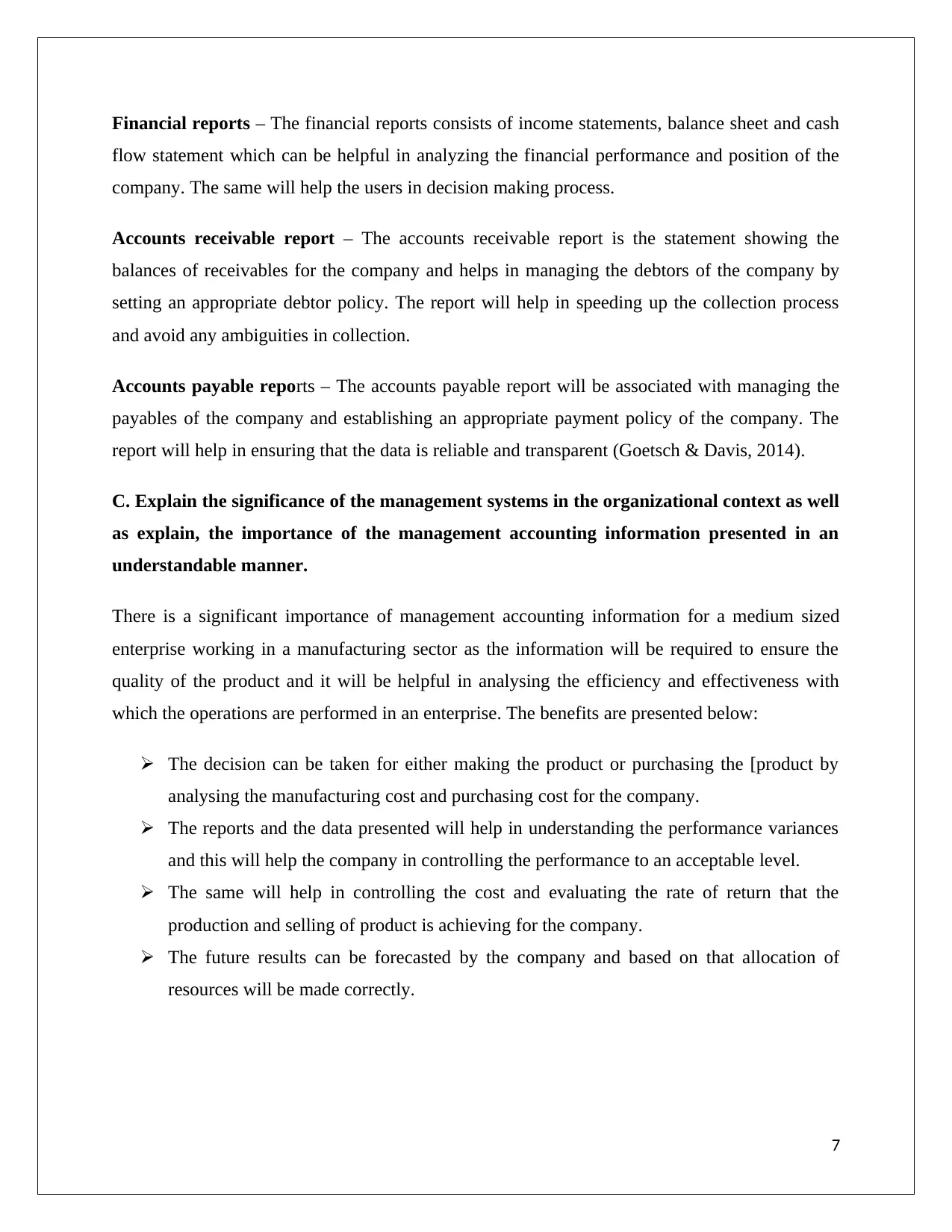
Financial reports – The financial reports consists of income statements, balance sheet and cash
flow statement which can be helpful in analyzing the financial performance and position of the
company. The same will help the users in decision making process.
Accounts receivable report – The accounts receivable report is the statement showing the
balances of receivables for the company and helps in managing the debtors of the company by
setting an appropriate debtor policy. The report will help in speeding up the collection process
and avoid any ambiguities in collection.
Accounts payable reports – The accounts payable report will be associated with managing the
payables of the company and establishing an appropriate payment policy of the company. The
report will help in ensuring that the data is reliable and transparent (Goetsch & Davis, 2014).
C. Explain the significance of the management systems in the organizational context as well
as explain, the importance of the management accounting information presented in an
understandable manner.
There is a significant importance of management accounting information for a medium sized
enterprise working in a manufacturing sector as the information will be required to ensure the
quality of the product and it will be helpful in analysing the efficiency and effectiveness with
which the operations are performed in an enterprise. The benefits are presented below:
The decision can be taken for either making the product or purchasing the [product by
analysing the manufacturing cost and purchasing cost for the company.
The reports and the data presented will help in understanding the performance variances
and this will help the company in controlling the performance to an acceptable level.
The same will help in controlling the cost and evaluating the rate of return that the
production and selling of product is achieving for the company.
The future results can be forecasted by the company and based on that allocation of
resources will be made correctly.
7
flow statement which can be helpful in analyzing the financial performance and position of the
company. The same will help the users in decision making process.
Accounts receivable report – The accounts receivable report is the statement showing the
balances of receivables for the company and helps in managing the debtors of the company by
setting an appropriate debtor policy. The report will help in speeding up the collection process
and avoid any ambiguities in collection.
Accounts payable reports – The accounts payable report will be associated with managing the
payables of the company and establishing an appropriate payment policy of the company. The
report will help in ensuring that the data is reliable and transparent (Goetsch & Davis, 2014).
C. Explain the significance of the management systems in the organizational context as well
as explain, the importance of the management accounting information presented in an
understandable manner.
There is a significant importance of management accounting information for a medium sized
enterprise working in a manufacturing sector as the information will be required to ensure the
quality of the product and it will be helpful in analysing the efficiency and effectiveness with
which the operations are performed in an enterprise. The benefits are presented below:
The decision can be taken for either making the product or purchasing the [product by
analysing the manufacturing cost and purchasing cost for the company.
The reports and the data presented will help in understanding the performance variances
and this will help the company in controlling the performance to an acceptable level.
The same will help in controlling the cost and evaluating the rate of return that the
production and selling of product is achieving for the company.
The future results can be forecasted by the company and based on that allocation of
resources will be made correctly.
7
Paraphrase This Document
Need a fresh take? Get an instant paraphrase of this document with our AI Paraphraser
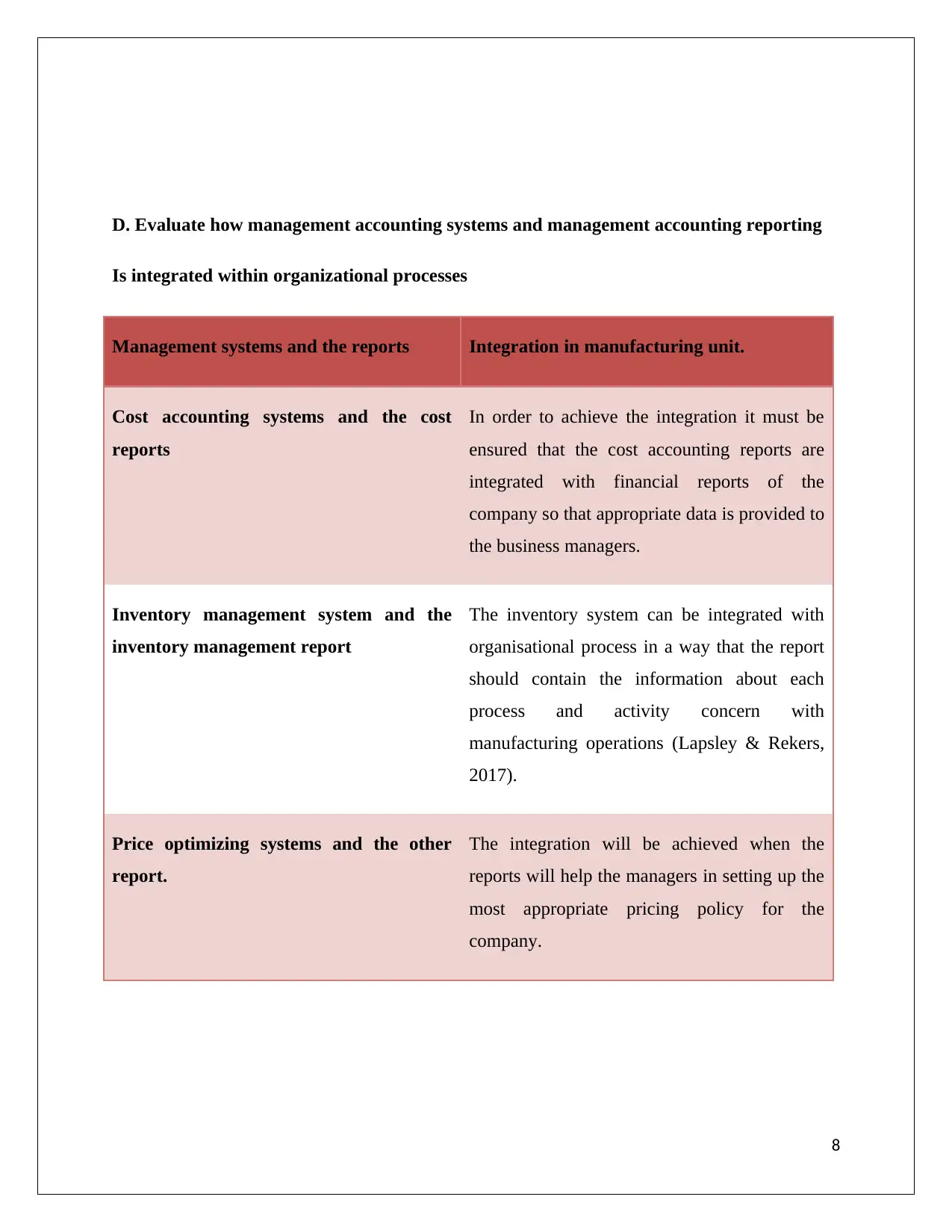
D. Evaluate how management accounting systems and management accounting reporting
Is integrated within organizational processes
Management systems and the reports Integration in manufacturing unit.
Cost accounting systems and the cost
reports
In order to achieve the integration it must be
ensured that the cost accounting reports are
integrated with financial reports of the
company so that appropriate data is provided to
the business managers.
Inventory management system and the
inventory management report
The inventory system can be integrated with
organisational process in a way that the report
should contain the information about each
process and activity concern with
manufacturing operations (Lapsley & Rekers,
2017).
Price optimizing systems and the other
report.
The integration will be achieved when the
reports will help the managers in setting up the
most appropriate pricing policy for the
company.
8
Is integrated within organizational processes
Management systems and the reports Integration in manufacturing unit.
Cost accounting systems and the cost
reports
In order to achieve the integration it must be
ensured that the cost accounting reports are
integrated with financial reports of the
company so that appropriate data is provided to
the business managers.
Inventory management system and the
inventory management report
The inventory system can be integrated with
organisational process in a way that the report
should contain the information about each
process and activity concern with
manufacturing operations (Lapsley & Rekers,
2017).
Price optimizing systems and the other
report.
The integration will be achieved when the
reports will help the managers in setting up the
most appropriate pricing policy for the
company.
8
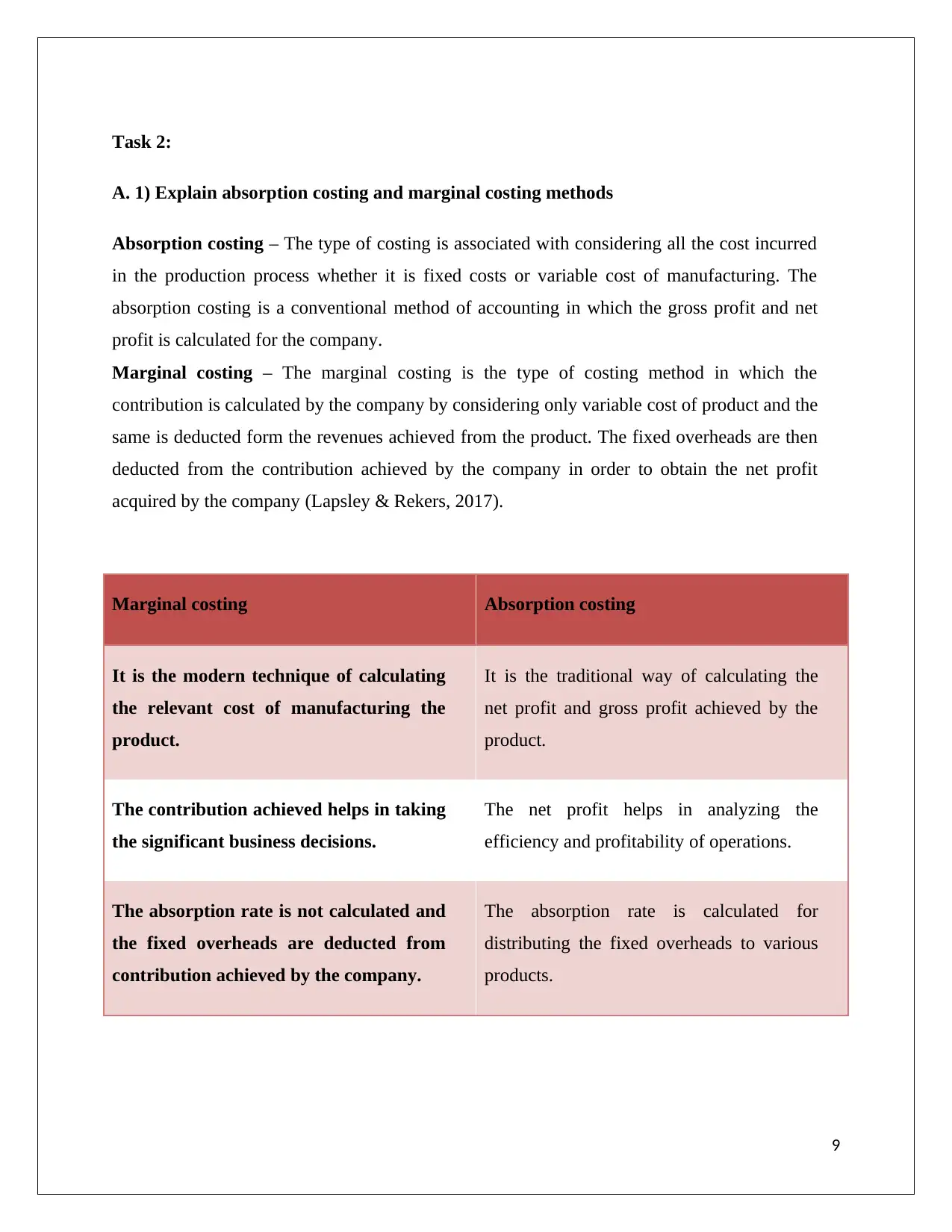
Task 2:
A. 1) Explain absorption costing and marginal costing methods
Absorption costing – The type of costing is associated with considering all the cost incurred
in the production process whether it is fixed costs or variable cost of manufacturing. The
absorption costing is a conventional method of accounting in which the gross profit and net
profit is calculated for the company.
Marginal costing – The marginal costing is the type of costing method in which the
contribution is calculated by the company by considering only variable cost of product and the
same is deducted form the revenues achieved from the product. The fixed overheads are then
deducted from the contribution achieved by the company in order to obtain the net profit
acquired by the company (Lapsley & Rekers, 2017).
Marginal costing Absorption costing
It is the modern technique of calculating
the relevant cost of manufacturing the
product.
It is the traditional way of calculating the
net profit and gross profit achieved by the
product.
The contribution achieved helps in taking
the significant business decisions.
The net profit helps in analyzing the
efficiency and profitability of operations.
The absorption rate is not calculated and
the fixed overheads are deducted from
contribution achieved by the company.
The absorption rate is calculated for
distributing the fixed overheads to various
products.
9
A. 1) Explain absorption costing and marginal costing methods
Absorption costing – The type of costing is associated with considering all the cost incurred
in the production process whether it is fixed costs or variable cost of manufacturing. The
absorption costing is a conventional method of accounting in which the gross profit and net
profit is calculated for the company.
Marginal costing – The marginal costing is the type of costing method in which the
contribution is calculated by the company by considering only variable cost of product and the
same is deducted form the revenues achieved from the product. The fixed overheads are then
deducted from the contribution achieved by the company in order to obtain the net profit
acquired by the company (Lapsley & Rekers, 2017).
Marginal costing Absorption costing
It is the modern technique of calculating
the relevant cost of manufacturing the
product.
It is the traditional way of calculating the
net profit and gross profit achieved by the
product.
The contribution achieved helps in taking
the significant business decisions.
The net profit helps in analyzing the
efficiency and profitability of operations.
The absorption rate is not calculated and
the fixed overheads are deducted from
contribution achieved by the company.
The absorption rate is calculated for
distributing the fixed overheads to various
products.
9
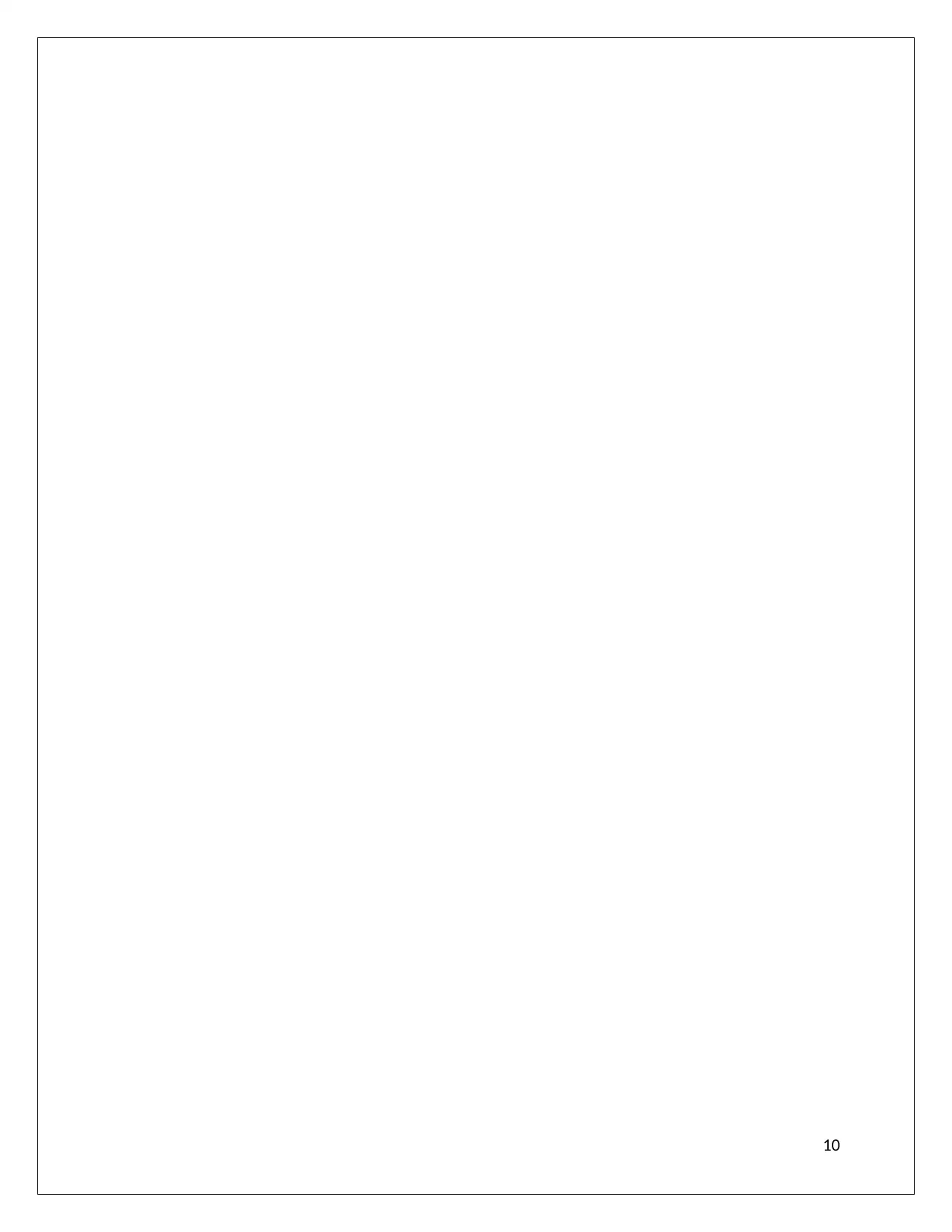
10
Secure Best Marks with AI Grader
Need help grading? Try our AI Grader for instant feedback on your assignments.

2) Prepare an Income Statement based on the calculations of costs as per the information
given above using both a) absorption costing method and b) marginal costing method.
Income statement as per marginal costing:
Income statement as per marginal costing
Particular Amount (₤)
Production units 800
Sales units 600
Sales @55 per unit 33000
Opening stock
Production cost: Variable
Direct material cost@ £7 per unit 5600
Direct labour @£ 6 per unit 4800
Other variable expenses @ £3 per unit 2400
Total Variable production cost 12800
Less: Closing stock 3200
Cost of goods sold 9600
Contribution 23400
Fixed Production Overhead 3200
Fixed Administration cost 1200
Fixed selling cost 1500
Net profit before tax 17500
11
given above using both a) absorption costing method and b) marginal costing method.
Income statement as per marginal costing:
Income statement as per marginal costing
Particular Amount (₤)
Production units 800
Sales units 600
Sales @55 per unit 33000
Opening stock
Production cost: Variable
Direct material cost@ £7 per unit 5600
Direct labour @£ 6 per unit 4800
Other variable expenses @ £3 per unit 2400
Total Variable production cost 12800
Less: Closing stock 3200
Cost of goods sold 9600
Contribution 23400
Fixed Production Overhead 3200
Fixed Administration cost 1200
Fixed selling cost 1500
Net profit before tax 17500
11
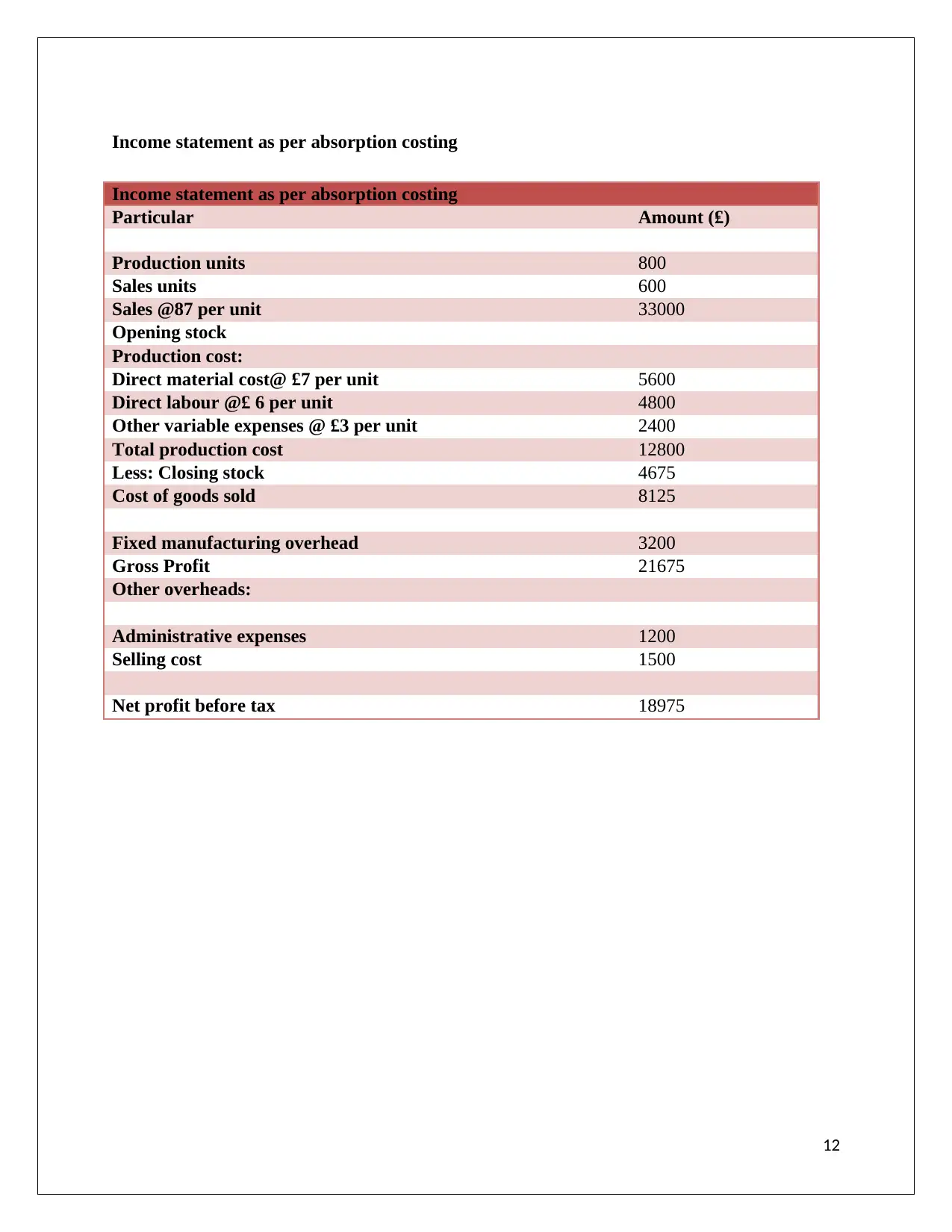
Income statement as per absorption costing
Income statement as per absorption costing
Particular Amount (₤)
Production units 800
Sales units 600
Sales @87 per unit 33000
Opening stock
Production cost:
Direct material cost@ £7 per unit 5600
Direct labour @£ 6 per unit 4800
Other variable expenses @ £3 per unit 2400
Total production cost 12800
Less: Closing stock 4675
Cost of goods sold 8125
Fixed manufacturing overhead 3200
Gross Profit 21675
Other overheads:
Administrative expenses 1200
Selling cost 1500
Net profit before tax 18975
12
Income statement as per absorption costing
Particular Amount (₤)
Production units 800
Sales units 600
Sales @87 per unit 33000
Opening stock
Production cost:
Direct material cost@ £7 per unit 5600
Direct labour @£ 6 per unit 4800
Other variable expenses @ £3 per unit 2400
Total production cost 12800
Less: Closing stock 4675
Cost of goods sold 8125
Fixed manufacturing overhead 3200
Gross Profit 21675
Other overheads:
Administrative expenses 1200
Selling cost 1500
Net profit before tax 18975
12
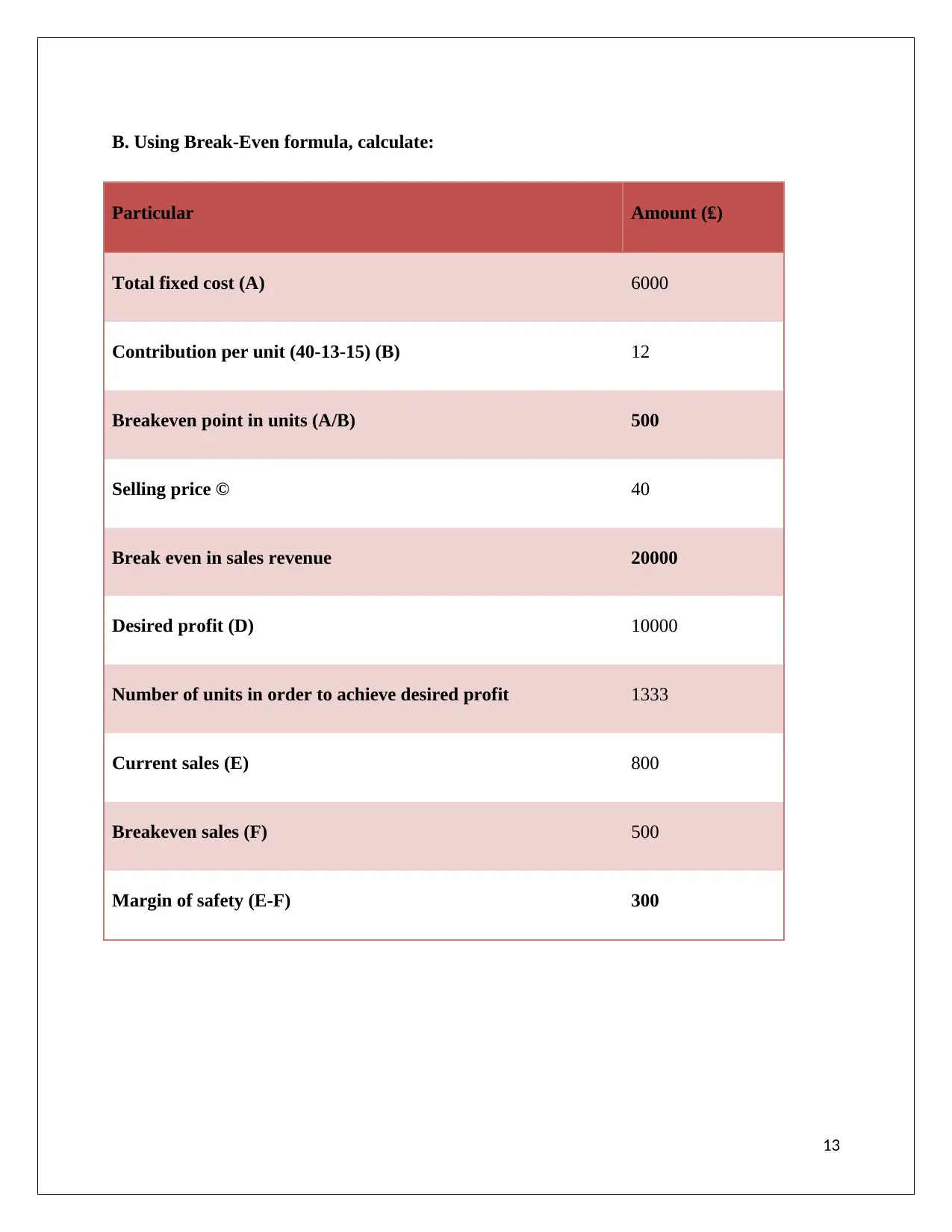
B. Using Break-Even formula, calculate:
Particular Amount (₤)
Total fixed cost (A) 6000
Contribution per unit (40-13-15) (B) 12
Breakeven point in units (A/B) 500
Selling price © 40
Break even in sales revenue 20000
Desired profit (D) 10000
Number of units in order to achieve desired profit 1333
Current sales (E) 800
Breakeven sales (F) 500
Margin of safety (E-F) 300
13
Particular Amount (₤)
Total fixed cost (A) 6000
Contribution per unit (40-13-15) (B) 12
Breakeven point in units (A/B) 500
Selling price © 40
Break even in sales revenue 20000
Desired profit (D) 10000
Number of units in order to achieve desired profit 1333
Current sales (E) 800
Breakeven sales (F) 500
Margin of safety (E-F) 300
13
Paraphrase This Document
Need a fresh take? Get an instant paraphrase of this document with our AI Paraphraser

C. Apply the range of management accounting techniques and produce appropriate
financial reporting documents.
Results of absorption costing statements – It can be observed that the income statement prepared
under absorption costing has resulted in a net profit of £18975 which is calculated after
considering the absorption rate calculated at budgeted level of activity performed by the
company. The gross profit in this case has been £21675 which has been reduced by all the selling
and distribution expenses to arrive at net profits (Hemmer & Labro, 2016).
Results of marginal costing statement – As per the marginal costing statement prepared by the
company it can be established that the contribution achieved has been £23400 and this has been
obtained after deducting all the variable cost from the revenues achieved by the product. The net
profit has been £17500 which has been achieved after deducting fixed overheads from the
contribution achieved by the company.
14
financial reporting documents.
Results of absorption costing statements – It can be observed that the income statement prepared
under absorption costing has resulted in a net profit of £18975 which is calculated after
considering the absorption rate calculated at budgeted level of activity performed by the
company. The gross profit in this case has been £21675 which has been reduced by all the selling
and distribution expenses to arrive at net profits (Hemmer & Labro, 2016).
Results of marginal costing statement – As per the marginal costing statement prepared by the
company it can be established that the contribution achieved has been £23400 and this has been
obtained after deducting all the variable cost from the revenues achieved by the product. The net
profit has been £17500 which has been achieved after deducting fixed overheads from the
contribution achieved by the company.
14
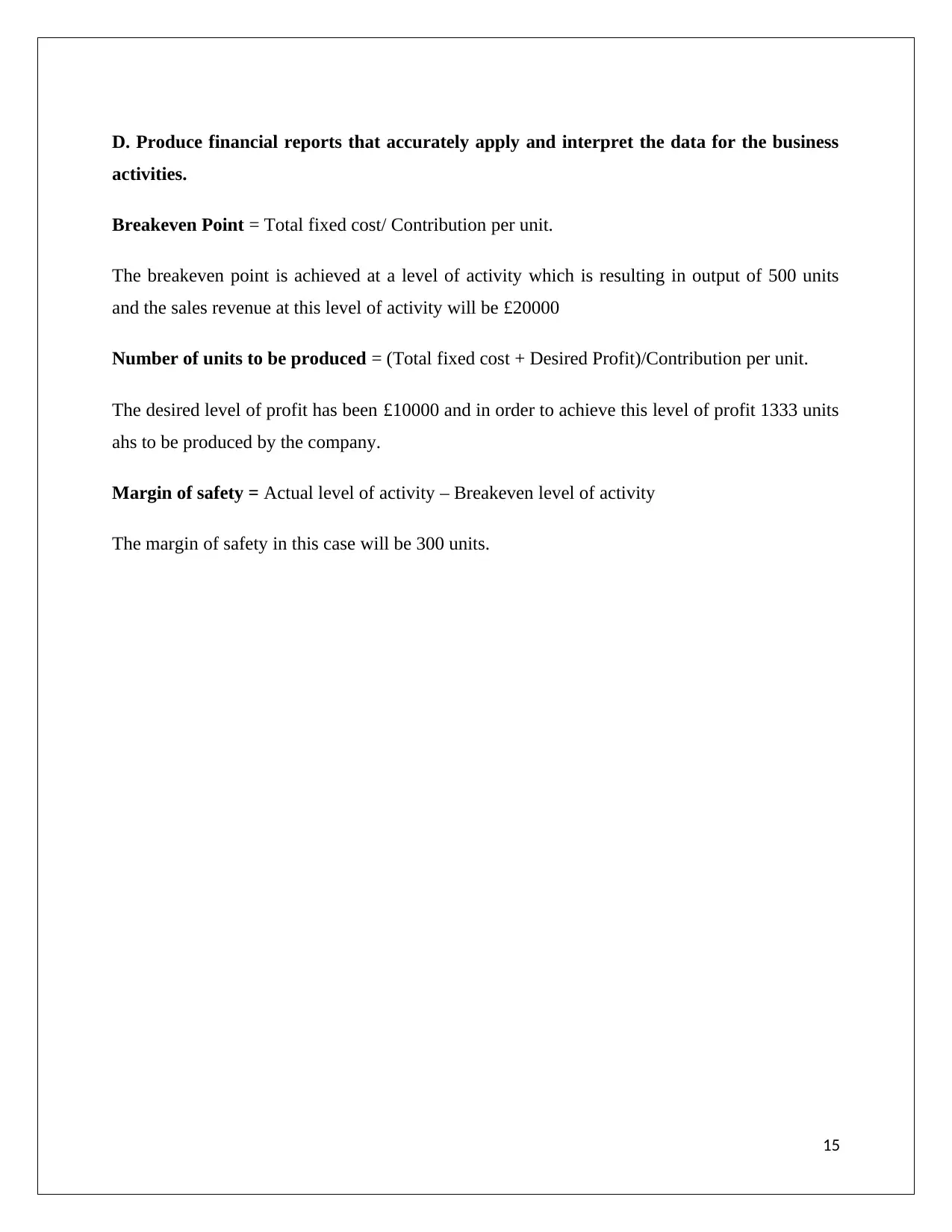
D. Produce financial reports that accurately apply and interpret the data for the business
activities.
Breakeven Point = Total fixed cost/ Contribution per unit.
The breakeven point is achieved at a level of activity which is resulting in output of 500 units
and the sales revenue at this level of activity will be £20000
Number of units to be produced = (Total fixed cost + Desired Profit)/Contribution per unit.
The desired level of profit has been £10000 and in order to achieve this level of profit 1333 units
ahs to be produced by the company.
Margin of safety = Actual level of activity – Breakeven level of activity
The margin of safety in this case will be 300 units.
15
activities.
Breakeven Point = Total fixed cost/ Contribution per unit.
The breakeven point is achieved at a level of activity which is resulting in output of 500 units
and the sales revenue at this level of activity will be £20000
Number of units to be produced = (Total fixed cost + Desired Profit)/Contribution per unit.
The desired level of profit has been £10000 and in order to achieve this level of profit 1333 units
ahs to be produced by the company.
Margin of safety = Actual level of activity – Breakeven level of activity
The margin of safety in this case will be 300 units.
15
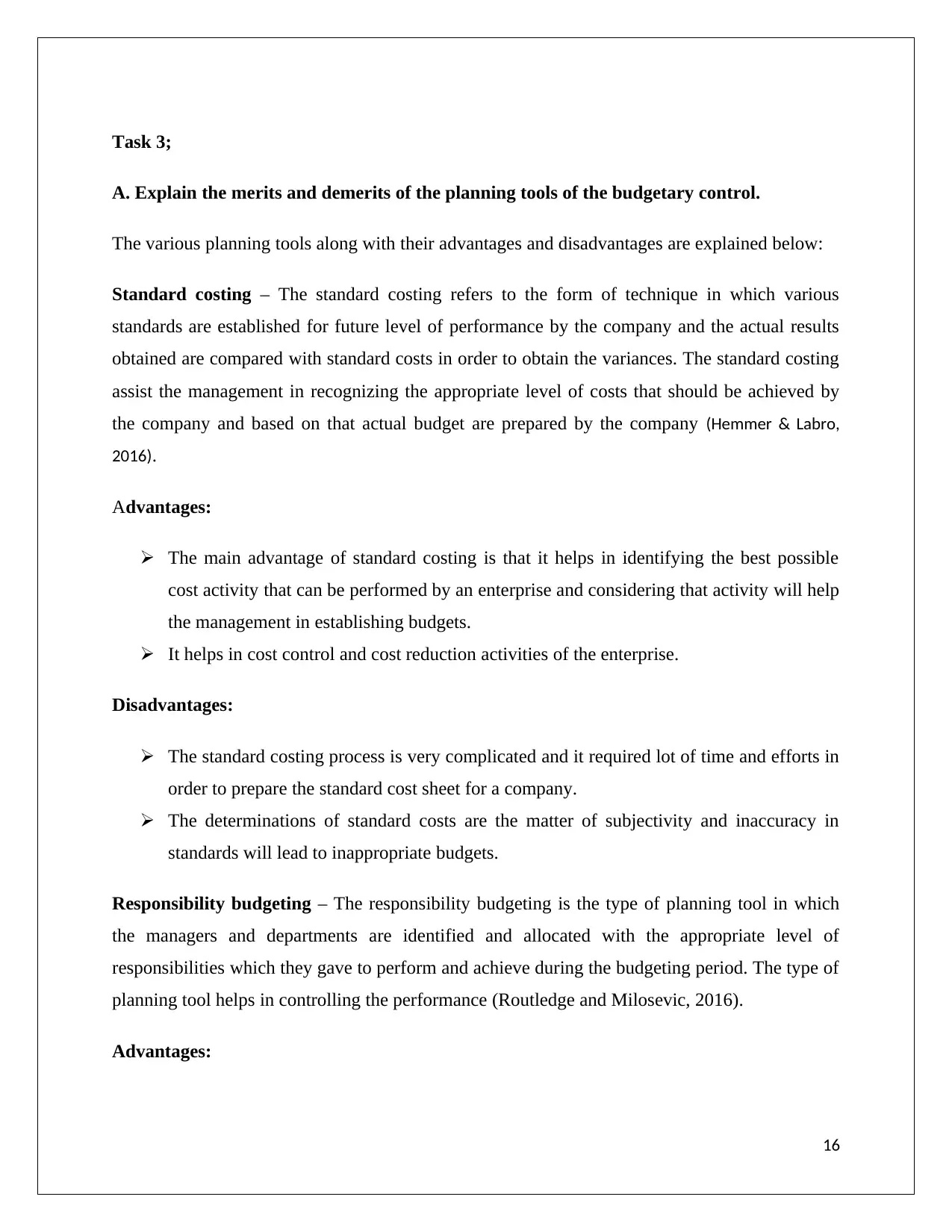
Task 3;
A. Explain the merits and demerits of the planning tools of the budgetary control.
The various planning tools along with their advantages and disadvantages are explained below:
Standard costing – The standard costing refers to the form of technique in which various
standards are established for future level of performance by the company and the actual results
obtained are compared with standard costs in order to obtain the variances. The standard costing
assist the management in recognizing the appropriate level of costs that should be achieved by
the company and based on that actual budget are prepared by the company (Hemmer & Labro,
2016).
Advantages:
The main advantage of standard costing is that it helps in identifying the best possible
cost activity that can be performed by an enterprise and considering that activity will help
the management in establishing budgets.
It helps in cost control and cost reduction activities of the enterprise.
Disadvantages:
The standard costing process is very complicated and it required lot of time and efforts in
order to prepare the standard cost sheet for a company.
The determinations of standard costs are the matter of subjectivity and inaccuracy in
standards will lead to inappropriate budgets.
Responsibility budgeting – The responsibility budgeting is the type of planning tool in which
the managers and departments are identified and allocated with the appropriate level of
responsibilities which they gave to perform and achieve during the budgeting period. The type of
planning tool helps in controlling the performance (Routledge and Milosevic, 2016).
Advantages:
16
A. Explain the merits and demerits of the planning tools of the budgetary control.
The various planning tools along with their advantages and disadvantages are explained below:
Standard costing – The standard costing refers to the form of technique in which various
standards are established for future level of performance by the company and the actual results
obtained are compared with standard costs in order to obtain the variances. The standard costing
assist the management in recognizing the appropriate level of costs that should be achieved by
the company and based on that actual budget are prepared by the company (Hemmer & Labro,
2016).
Advantages:
The main advantage of standard costing is that it helps in identifying the best possible
cost activity that can be performed by an enterprise and considering that activity will help
the management in establishing budgets.
It helps in cost control and cost reduction activities of the enterprise.
Disadvantages:
The standard costing process is very complicated and it required lot of time and efforts in
order to prepare the standard cost sheet for a company.
The determinations of standard costs are the matter of subjectivity and inaccuracy in
standards will lead to inappropriate budgets.
Responsibility budgeting – The responsibility budgeting is the type of planning tool in which
the managers and departments are identified and allocated with the appropriate level of
responsibilities which they gave to perform and achieve during the budgeting period. The type of
planning tool helps in controlling the performance (Routledge and Milosevic, 2016).
Advantages:
16
Secure Best Marks with AI Grader
Need help grading? Try our AI Grader for instant feedback on your assignments.
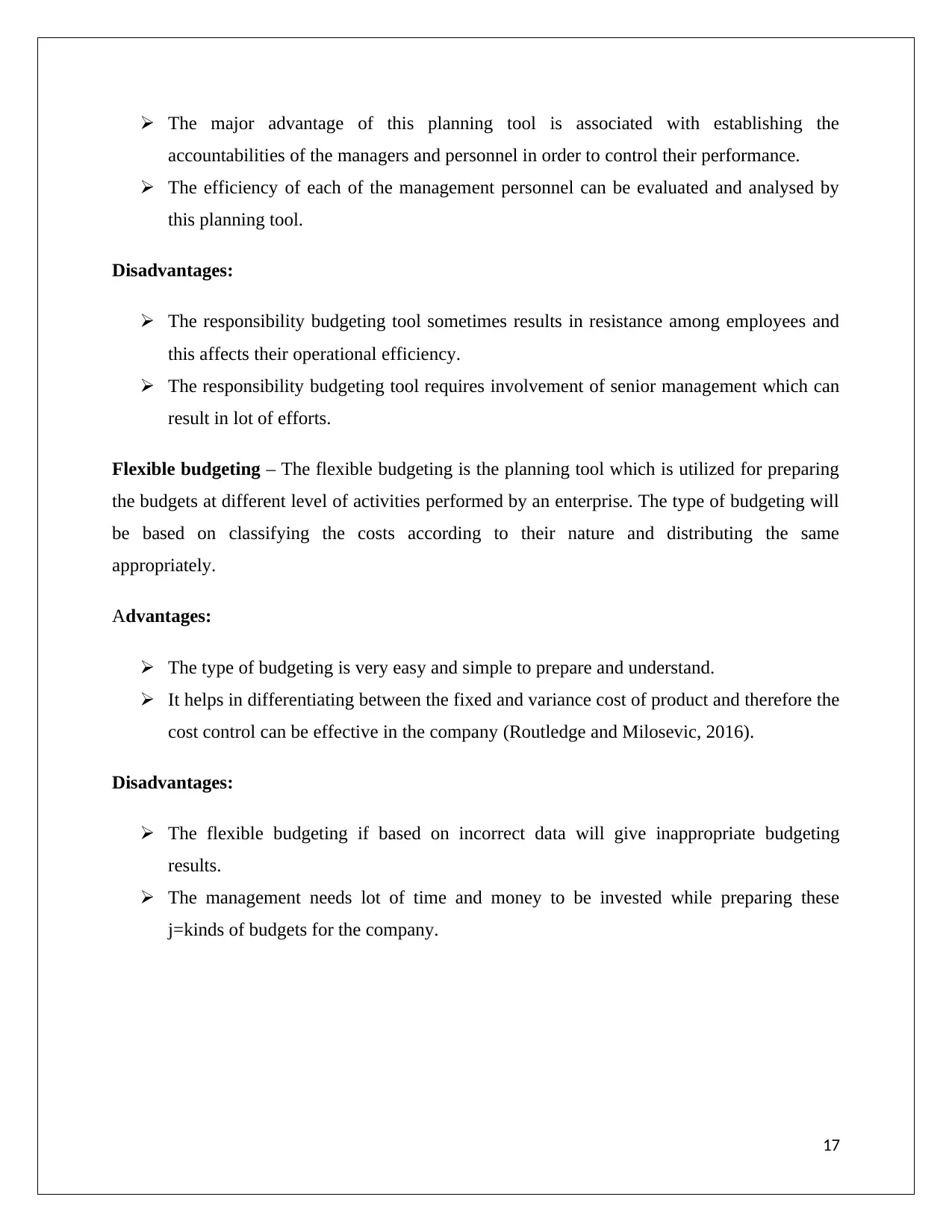
The major advantage of this planning tool is associated with establishing the
accountabilities of the managers and personnel in order to control their performance.
The efficiency of each of the management personnel can be evaluated and analysed by
this planning tool.
Disadvantages:
The responsibility budgeting tool sometimes results in resistance among employees and
this affects their operational efficiency.
The responsibility budgeting tool requires involvement of senior management which can
result in lot of efforts.
Flexible budgeting – The flexible budgeting is the planning tool which is utilized for preparing
the budgets at different level of activities performed by an enterprise. The type of budgeting will
be based on classifying the costs according to their nature and distributing the same
appropriately.
Advantages:
The type of budgeting is very easy and simple to prepare and understand.
It helps in differentiating between the fixed and variance cost of product and therefore the
cost control can be effective in the company (Routledge and Milosevic, 2016).
Disadvantages:
The flexible budgeting if based on incorrect data will give inappropriate budgeting
results.
The management needs lot of time and money to be invested while preparing these
j=kinds of budgets for the company.
17
accountabilities of the managers and personnel in order to control their performance.
The efficiency of each of the management personnel can be evaluated and analysed by
this planning tool.
Disadvantages:
The responsibility budgeting tool sometimes results in resistance among employees and
this affects their operational efficiency.
The responsibility budgeting tool requires involvement of senior management which can
result in lot of efforts.
Flexible budgeting – The flexible budgeting is the planning tool which is utilized for preparing
the budgets at different level of activities performed by an enterprise. The type of budgeting will
be based on classifying the costs according to their nature and distributing the same
appropriately.
Advantages:
The type of budgeting is very easy and simple to prepare and understand.
It helps in differentiating between the fixed and variance cost of product and therefore the
cost control can be effective in the company (Routledge and Milosevic, 2016).
Disadvantages:
The flexible budgeting if based on incorrect data will give inappropriate budgeting
results.
The management needs lot of time and money to be invested while preparing these
j=kinds of budgets for the company.
17
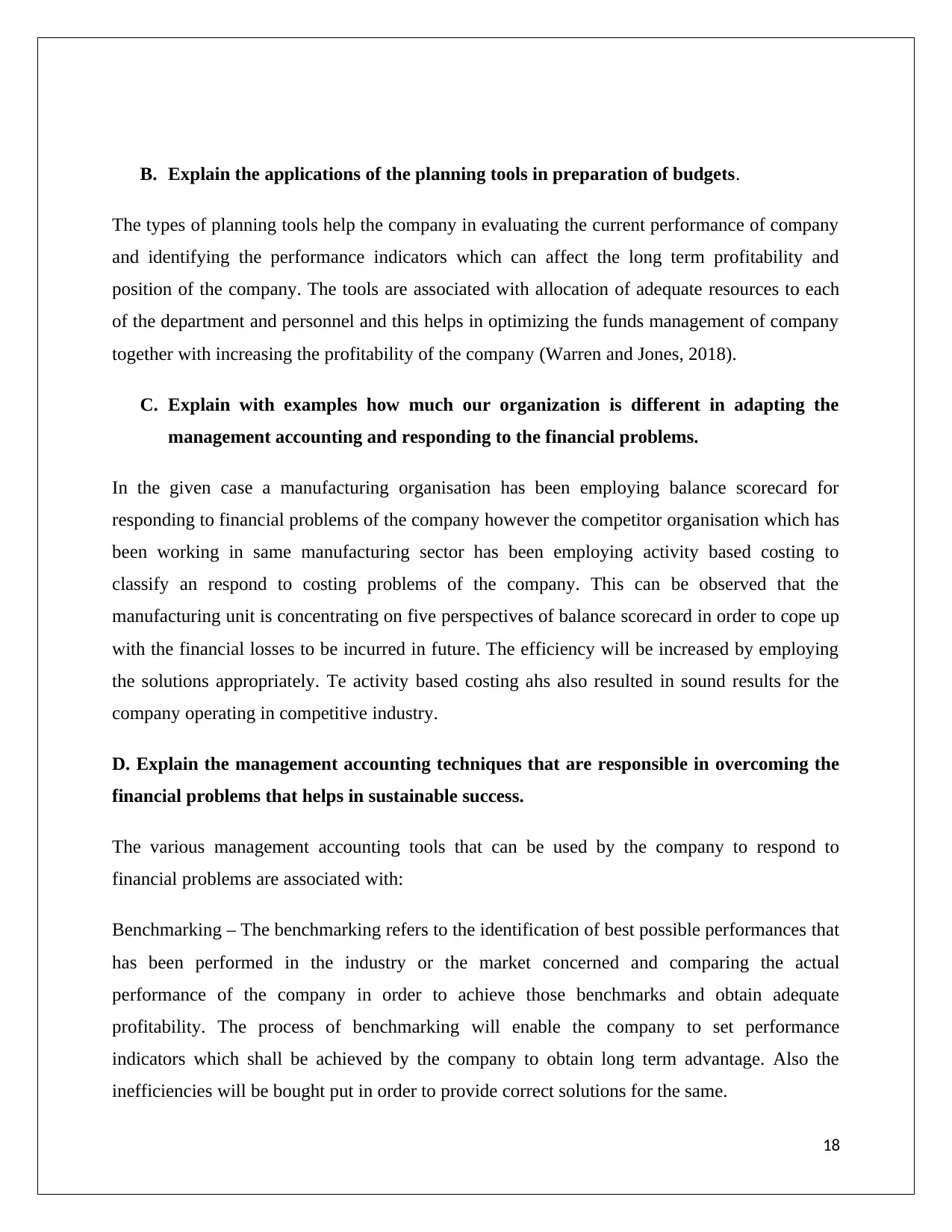
B. Explain the applications of the planning tools in preparation of budgets.
The types of planning tools help the company in evaluating the current performance of company
and identifying the performance indicators which can affect the long term profitability and
position of the company. The tools are associated with allocation of adequate resources to each
of the department and personnel and this helps in optimizing the funds management of company
together with increasing the profitability of the company (Warren and Jones, 2018).
C. Explain with examples how much our organization is different in adapting the
management accounting and responding to the financial problems.
In the given case a manufacturing organisation has been employing balance scorecard for
responding to financial problems of the company however the competitor organisation which has
been working in same manufacturing sector has been employing activity based costing to
classify an respond to costing problems of the company. This can be observed that the
manufacturing unit is concentrating on five perspectives of balance scorecard in order to cope up
with the financial losses to be incurred in future. The efficiency will be increased by employing
the solutions appropriately. Te activity based costing ahs also resulted in sound results for the
company operating in competitive industry.
D. Explain the management accounting techniques that are responsible in overcoming the
financial problems that helps in sustainable success.
The various management accounting tools that can be used by the company to respond to
financial problems are associated with:
Benchmarking – The benchmarking refers to the identification of best possible performances that
has been performed in the industry or the market concerned and comparing the actual
performance of the company in order to achieve those benchmarks and obtain adequate
profitability. The process of benchmarking will enable the company to set performance
indicators which shall be achieved by the company to obtain long term advantage. Also the
inefficiencies will be bought put in order to provide correct solutions for the same.
18
The types of planning tools help the company in evaluating the current performance of company
and identifying the performance indicators which can affect the long term profitability and
position of the company. The tools are associated with allocation of adequate resources to each
of the department and personnel and this helps in optimizing the funds management of company
together with increasing the profitability of the company (Warren and Jones, 2018).
C. Explain with examples how much our organization is different in adapting the
management accounting and responding to the financial problems.
In the given case a manufacturing organisation has been employing balance scorecard for
responding to financial problems of the company however the competitor organisation which has
been working in same manufacturing sector has been employing activity based costing to
classify an respond to costing problems of the company. This can be observed that the
manufacturing unit is concentrating on five perspectives of balance scorecard in order to cope up
with the financial losses to be incurred in future. The efficiency will be increased by employing
the solutions appropriately. Te activity based costing ahs also resulted in sound results for the
company operating in competitive industry.
D. Explain the management accounting techniques that are responsible in overcoming the
financial problems that helps in sustainable success.
The various management accounting tools that can be used by the company to respond to
financial problems are associated with:
Benchmarking – The benchmarking refers to the identification of best possible performances that
has been performed in the industry or the market concerned and comparing the actual
performance of the company in order to achieve those benchmarks and obtain adequate
profitability. The process of benchmarking will enable the company to set performance
indicators which shall be achieved by the company to obtain long term advantage. Also the
inefficiencies will be bought put in order to provide correct solutions for the same.
18
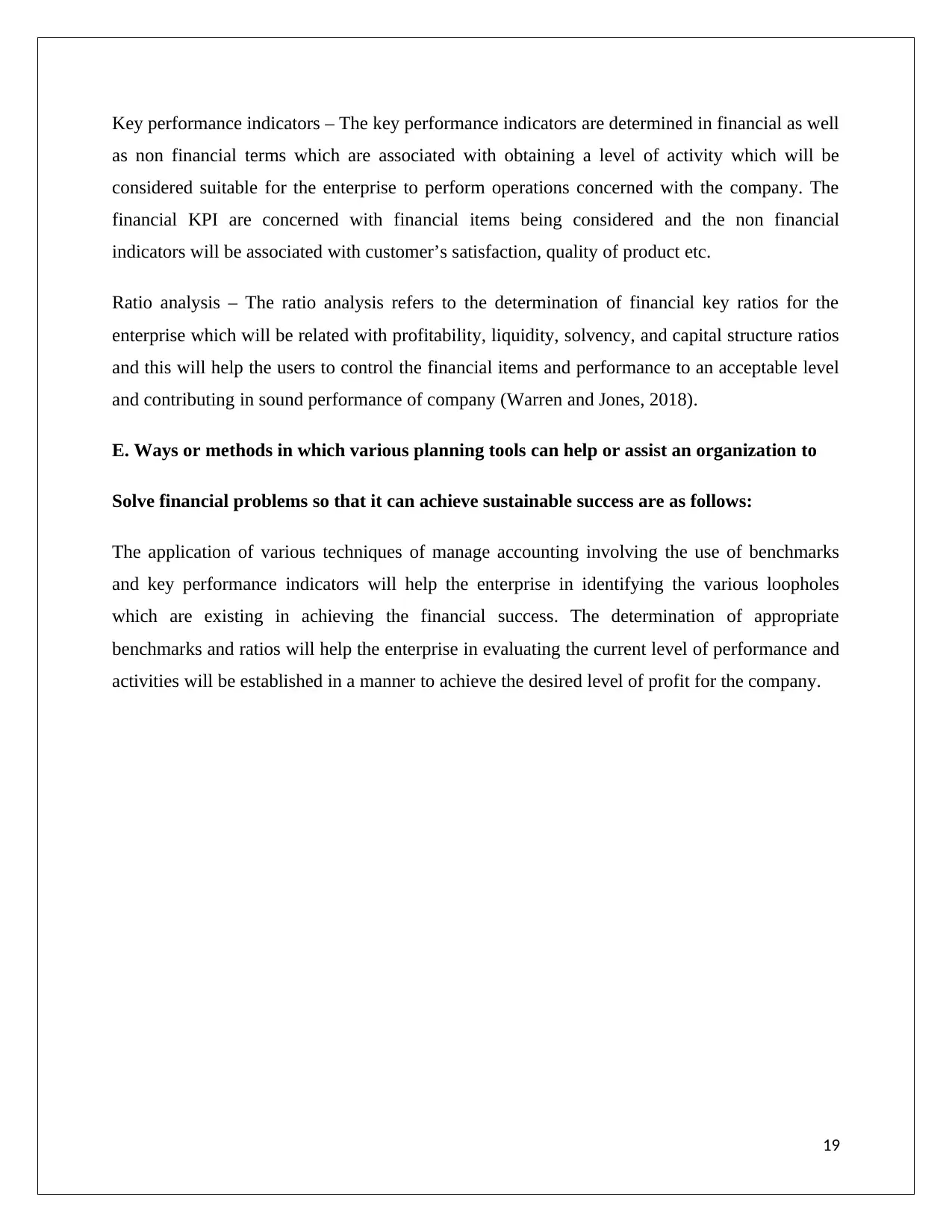
Key performance indicators – The key performance indicators are determined in financial as well
as non financial terms which are associated with obtaining a level of activity which will be
considered suitable for the enterprise to perform operations concerned with the company. The
financial KPI are concerned with financial items being considered and the non financial
indicators will be associated with customer’s satisfaction, quality of product etc.
Ratio analysis – The ratio analysis refers to the determination of financial key ratios for the
enterprise which will be related with profitability, liquidity, solvency, and capital structure ratios
and this will help the users to control the financial items and performance to an acceptable level
and contributing in sound performance of company (Warren and Jones, 2018).
E. Ways or methods in which various planning tools can help or assist an organization to
Solve financial problems so that it can achieve sustainable success are as follows:
The application of various techniques of manage accounting involving the use of benchmarks
and key performance indicators will help the enterprise in identifying the various loopholes
which are existing in achieving the financial success. The determination of appropriate
benchmarks and ratios will help the enterprise in evaluating the current level of performance and
activities will be established in a manner to achieve the desired level of profit for the company.
19
as non financial terms which are associated with obtaining a level of activity which will be
considered suitable for the enterprise to perform operations concerned with the company. The
financial KPI are concerned with financial items being considered and the non financial
indicators will be associated with customer’s satisfaction, quality of product etc.
Ratio analysis – The ratio analysis refers to the determination of financial key ratios for the
enterprise which will be related with profitability, liquidity, solvency, and capital structure ratios
and this will help the users to control the financial items and performance to an acceptable level
and contributing in sound performance of company (Warren and Jones, 2018).
E. Ways or methods in which various planning tools can help or assist an organization to
Solve financial problems so that it can achieve sustainable success are as follows:
The application of various techniques of manage accounting involving the use of benchmarks
and key performance indicators will help the enterprise in identifying the various loopholes
which are existing in achieving the financial success. The determination of appropriate
benchmarks and ratios will help the enterprise in evaluating the current level of performance and
activities will be established in a manner to achieve the desired level of profit for the company.
19
Paraphrase This Document
Need a fresh take? Get an instant paraphrase of this document with our AI Paraphraser
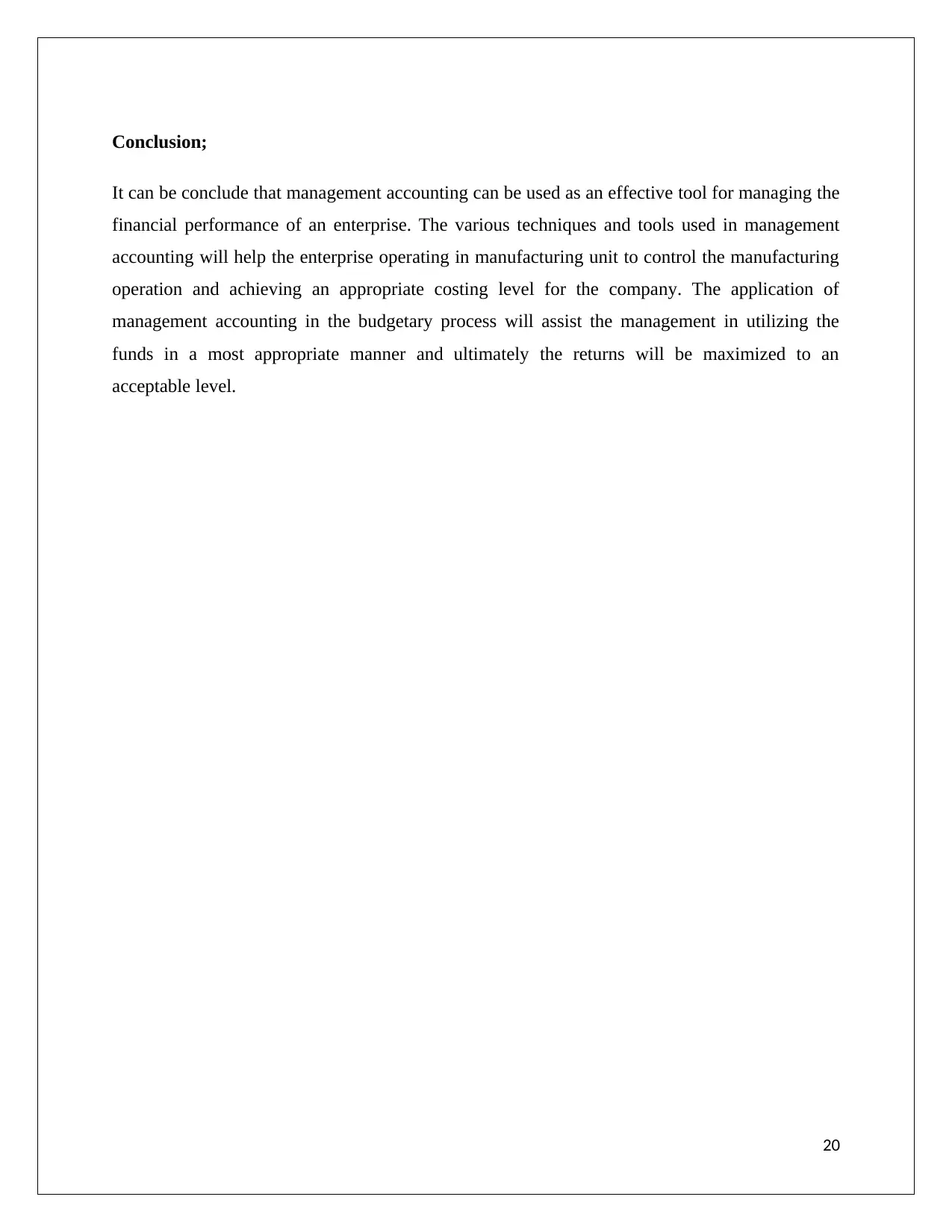
Conclusion;
It can be conclude that management accounting can be used as an effective tool for managing the
financial performance of an enterprise. The various techniques and tools used in management
accounting will help the enterprise operating in manufacturing unit to control the manufacturing
operation and achieving an appropriate costing level for the company. The application of
management accounting in the budgetary process will assist the management in utilizing the
funds in a most appropriate manner and ultimately the returns will be maximized to an
acceptable level.
20
It can be conclude that management accounting can be used as an effective tool for managing the
financial performance of an enterprise. The various techniques and tools used in management
accounting will help the enterprise operating in manufacturing unit to control the manufacturing
operation and achieving an appropriate costing level for the company. The application of
management accounting in the budgetary process will assist the management in utilizing the
funds in a most appropriate manner and ultimately the returns will be maximized to an
acceptable level.
20
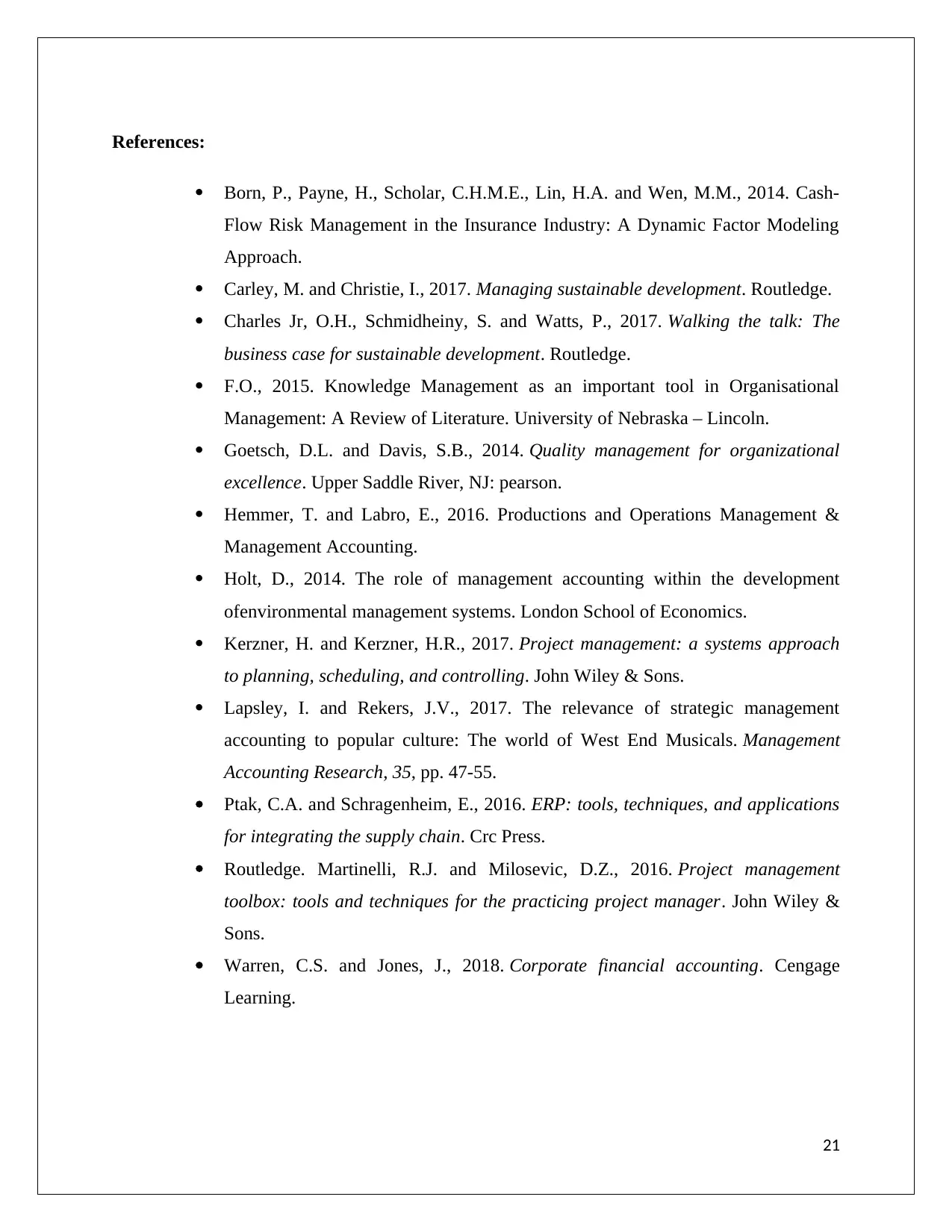
References:
Born, P., Payne, H., Scholar, C.H.M.E., Lin, H.A. and Wen, M.M., 2014. Cash-
Flow Risk Management in the Insurance Industry: A Dynamic Factor Modeling
Approach.
Carley, M. and Christie, I., 2017. Managing sustainable development. Routledge.
Charles Jr, O.H., Schmidheiny, S. and Watts, P., 2017. Walking the talk: The
business case for sustainable development. Routledge.
F.O., 2015. Knowledge Management as an important tool in Organisational
Management: A Review of Literature. University of Nebraska – Lincoln.
Goetsch, D.L. and Davis, S.B., 2014. Quality management for organizational
excellence. Upper Saddle River, NJ: pearson.
Hemmer, T. and Labro, E., 2016. Productions and Operations Management &
Management Accounting.
Holt, D., 2014. The role of management accounting within the development
ofenvironmental management systems. London School of Economics.
Kerzner, H. and Kerzner, H.R., 2017. Project management: a systems approach
to planning, scheduling, and controlling. John Wiley & Sons.
Lapsley, I. and Rekers, J.V., 2017. The relevance of strategic management
accounting to popular culture: The world of West End Musicals. Management
Accounting Research, 35, pp. 47-55.
Ptak, C.A. and Schragenheim, E., 2016. ERP: tools, techniques, and applications
for integrating the supply chain. Crc Press.
Routledge. Martinelli, R.J. and Milosevic, D.Z., 2016. Project management
toolbox: tools and techniques for the practicing project manager. John Wiley &
Sons.
Warren, C.S. and Jones, J., 2018. Corporate financial accounting. Cengage
Learning.
21
Born, P., Payne, H., Scholar, C.H.M.E., Lin, H.A. and Wen, M.M., 2014. Cash-
Flow Risk Management in the Insurance Industry: A Dynamic Factor Modeling
Approach.
Carley, M. and Christie, I., 2017. Managing sustainable development. Routledge.
Charles Jr, O.H., Schmidheiny, S. and Watts, P., 2017. Walking the talk: The
business case for sustainable development. Routledge.
F.O., 2015. Knowledge Management as an important tool in Organisational
Management: A Review of Literature. University of Nebraska – Lincoln.
Goetsch, D.L. and Davis, S.B., 2014. Quality management for organizational
excellence. Upper Saddle River, NJ: pearson.
Hemmer, T. and Labro, E., 2016. Productions and Operations Management &
Management Accounting.
Holt, D., 2014. The role of management accounting within the development
ofenvironmental management systems. London School of Economics.
Kerzner, H. and Kerzner, H.R., 2017. Project management: a systems approach
to planning, scheduling, and controlling. John Wiley & Sons.
Lapsley, I. and Rekers, J.V., 2017. The relevance of strategic management
accounting to popular culture: The world of West End Musicals. Management
Accounting Research, 35, pp. 47-55.
Ptak, C.A. and Schragenheim, E., 2016. ERP: tools, techniques, and applications
for integrating the supply chain. Crc Press.
Routledge. Martinelli, R.J. and Milosevic, D.Z., 2016. Project management
toolbox: tools and techniques for the practicing project manager. John Wiley &
Sons.
Warren, C.S. and Jones, J., 2018. Corporate financial accounting. Cengage
Learning.
21
1 out of 21
Related Documents
Your All-in-One AI-Powered Toolkit for Academic Success.
+13062052269
info@desklib.com
Available 24*7 on WhatsApp / Email
![[object Object]](/_next/static/media/star-bottom.7253800d.svg)
Unlock your academic potential
© 2024 | Zucol Services PVT LTD | All rights reserved.





